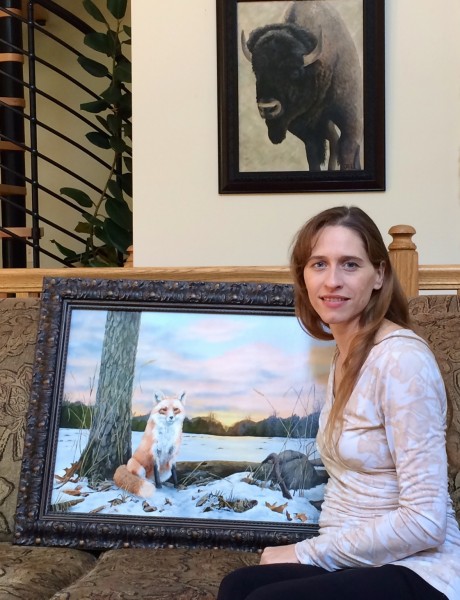Passions For Art, Biology Combine

With a background in biology, Jennifer Caudill combined her passion for animals with her passion for art to create beautiful paintings. (Photo by Rebekah Whirledge)
The most noticeable feature of Jennifer Caudill’s artwork is the fine detail of the wildlife she paints. The deer look pensive and alert — about to leap off the edges of the canvas if spooked — and the lion’s mane contains thousands of individual brush strokes to make up each hair on his head. What may not be noticed, however, is the detail Caudill places to accurately portray the wildlife. Behind each of her paintings is hours of research, both in physical observation and book study.
That level of dedication is thanks to Caudill’s background. With a degree in biology from Manchester University, she worked for 10 years as a microbiologist at a local laboratory.
“My painting are almost scientific illustrations,” said Caudill, who uses acrylics for her work. “I always portray the animal in the correct habitat, either by taking good reference photos or gathering information about environment and ecosystem.”
While Caudill has observed a box turtle, deer and a family of foxes in her own wooded backyard between Mentone and Warsaw, she uses zoo animals as models for wildlife from other parts of the world. That isn’t to say Caudill’s paintings can only be seen in a science textbook. She instead paints for pleasure.
“Painting is a hobby. It’s something I’ve always done from when I was little and would sit and paint with my grandmother in the summers.”
A stay-at-home mother to two boys, Caudill admitted because she is a perfectionist, painting isn’t a stress reliever. Instead, she has her own horse for that, which she rides dressage. Eventually, she’d like to take a good photo of her horse in motion to paint, too.
“It takes a lot of organization for me to paint. Both in getting up early before my boys and by spending hours in research for each animal,” she said. “For a painting of a jaguar, I first observed it at the zoo in Chicago and then spent eight hours in study to make sure I portrayed it in the right environment.”
She has also recently found an appreciation for seeking out other artists’ paintings at museums, too.
“I didn’t like to go to museums because I didn’t want to feel like I was copying other artists,” Caudill explained. “But after a trip to the Louvre in Paris, I realized I need to study other artists and their techniques in order to improve my own technique. I can tell a big difference between my paintings before and after the Louvre.”
Influential artists Caudill admires include Terry Isaac, Eugène Delacroix and Elisabeth Le Brun.
Locally, Caudill is a member of the Artist Forum, a group of local artists gathering monthly to critique each other’s work and share ideas. She is also a member of Indiana Wildlife Artists, and recently received first place at that group’s show in Indianapolis.
Caudill grew up in Akron, but now lives in Warsaw. Her husband, Jorge Penaherrera, while not an artist, is also creative. He plays the piano and is currently teaching his sons to do the same while Caudill teaches them to paint.
“We think it’s important for our boys to grow up with an appreciation of the art culture,” she said.
“When people view my paintings, I hope it brings them an environmental awareness and they see how beautiful nature can be.”
